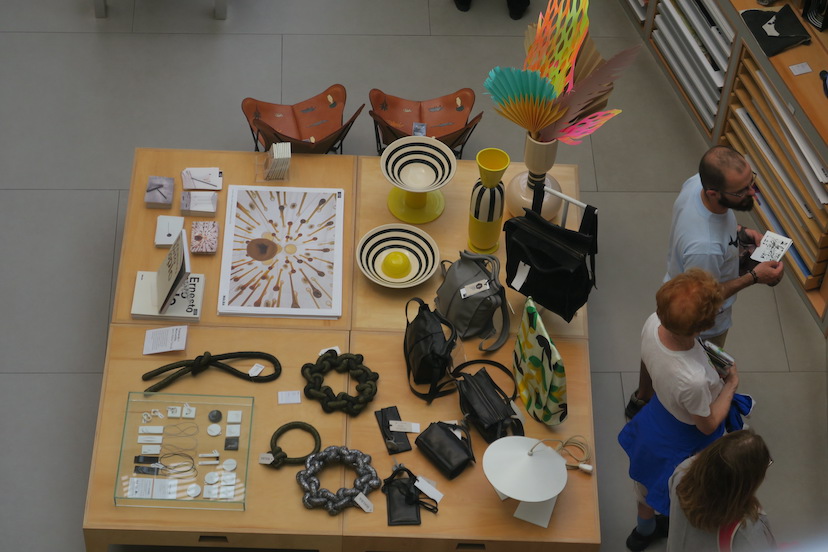
Assorted works by Argentinian designers are available for purchase at the Museum of Modern Art in Buenos Aires. Photo by Nancy Wigston
Travelers often find themselves seeking unusual items while on the road. These curios may be explained by the psychology behind the souvenir–the French word for “memory.” As we hold a souvenir in our hands—a model of the Eiffel Tower, a postcard of Angkor Wat, a silk scarf from Vietnam—we are transported back in time to places where we escaped the drudgery of daily existence. Tangible memories have no price and can come in the smallest forms.
Among my most treasured souvenirs is a white bookmark stamped “Annual Glugor Firewalking, 1977” that conjures up a tropical evening in Penang, Malaysia when I gazed in wonder as sarong-clad faithful slowly walked barefoot over smoldering coals. Another is a tiny matchbox bearing the royal likenesses of Charles and Diana purchased just before their wedding during a simpler time in London.
Souvenirs needn’t be expensive but, like my earrings from a Lisu village in the Golden Triangle, they must be locally made if they ever are to become a tangible memory, a keepsake.
Here are some of my tangible memories acquired during four seasons of shopping. May they inspire you to leave the hotel, break away from the guided tour and explore neighborhoods not detailed in the guidebook.
Winter in Victoria
“You’re coming to a rainforest,” friends warned before we visited Victoria last winter. They greeted us with daffodils from their garden after our plane touched down, in February. Thousands of visitors flock to Vancouver Island for Victoria’s mild winters, where snow is a rarity, and the folks are warm. “I have to tell you I love your outfit!” calls a woman as I stroll by brightly painted 19th-century homes. I smile a thank-you.
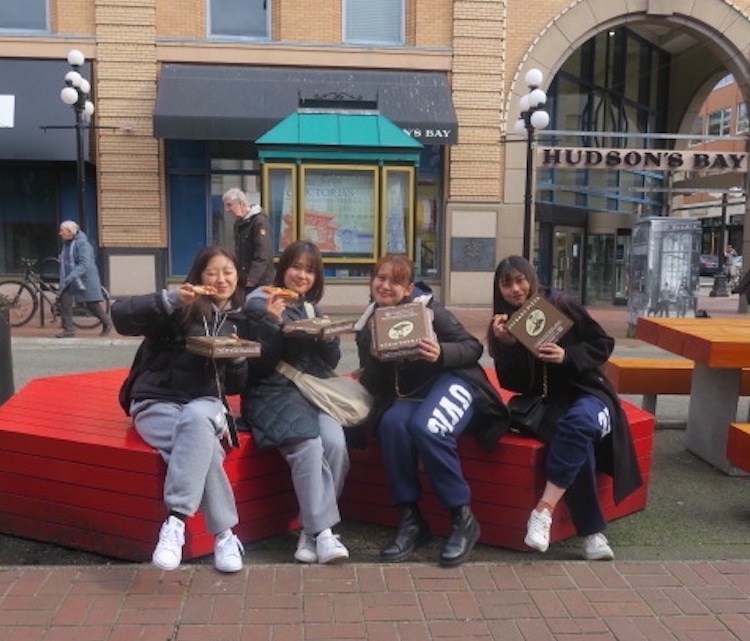
Tourists eating pizza in downtown Victoria. Photo by Nancy Wigston
Village-like, magnificently treed, Victoria in winter is a magnet for hikers, bikers and cold water swimmers–oblivious to hypothermia. Quirky post-impressionist artist Emily Carr–inspired by the indigenous peoples of the Pacific Northwest–traveled the island in her campervan, “The Elephant,” painting remote totem poles, pet monkey in tow. Her books are sold at Carr House, around the corner from our rental condo. The first thing I buy in Victoria are Carr art cards to send home and to leave in tribute, with others, on her gravesite in Ross Bay Cemetery.
Victoria’s provincial Parliament Buildings offer free tours—there’s a soaring cupola, intricate stained-glass windows and carved oak doors. The Gift Shop is bargain-priced. “Girls belong in the House [of Parliament]!” is a winner. (I get two.) Totem poles dot the vast green lawns, where a recent gathering aimed at saving Old Growth trees inspired a surprise appearance by singer-songwriter Neil Young.
At the Birdcage Confectionery, facing Parliament, fresh flowers arrive daily along with homemade treats like the Nanaimo Bar, named for a Vancouver Island town. This no-bake butter, sugar and chocolate treat shot to popularity when World War Two rationing ended. Far pricier is High Tea at Victoria’s dowager Empress Hotel, a bucket-list event that hearkens back to the time when Victoria was hyped as a “bit of olde England,” instead of what it really was, a stop on the Gold Rush route north.
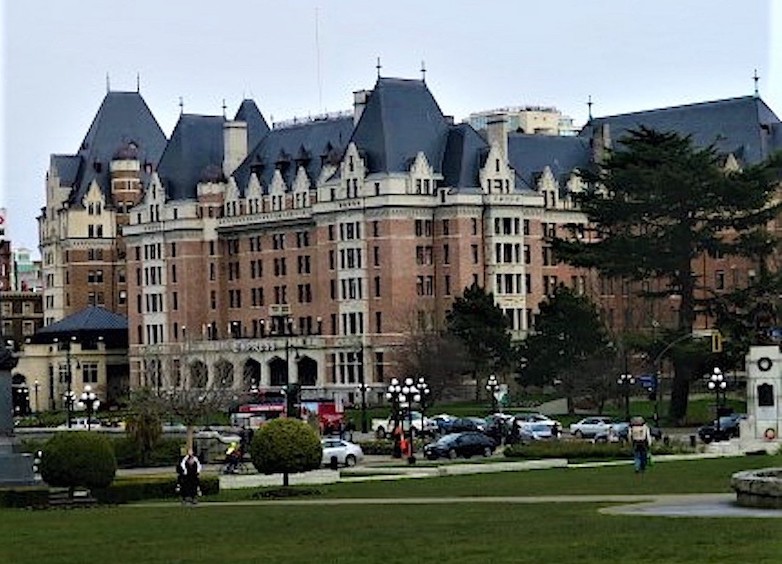
The regal Empress Hotel in Victoria occupies most of a city block, attracting guests who celebrate special occasions with its famously elaborate afternoon teas. Photo by Nancy Wigston
Fort Victoria, an outpost of the 17th century Hudson Bay Company, was the first stop for gold-seekers from California, Australia, Hawaii, and China’s Guangdong Province, thousands of whom just stayed. Poet Robert Service worked in a bank while spinning legends about the “strange things done in the midnight sun by the men who moil for gold,” lines most Canadians know by heart.
In Canada’s oldest Chinatown, ultra-narrow Fan Tan Alley boasts an impressive new Chinatown Museum, alongside silk emporia, a vinyl record store and something called an Umbrellatorium—well-suited for Victoria’s climate. After exploring the small and enticing Art Gallery of Greater Victoria with its focus on Pacific Rim Art, a young woman in the gift shop kindly hands me a post-it note listing her favorite vintage shops, from the Salvation Army to a place called Vintage After Death. (I visit them all.)
Downtown cafés (“Hey Happy” becomes our haunt) and boutiques speak to the city’s historical diversity: Irish linen shops, cashmere woven in Mongolia, Coastal Salish Indigenous arts, and Murchies café for tea, where I buy a box of “CBC Radio,” a tea blend named for the nation’s national broadcasting corporation.
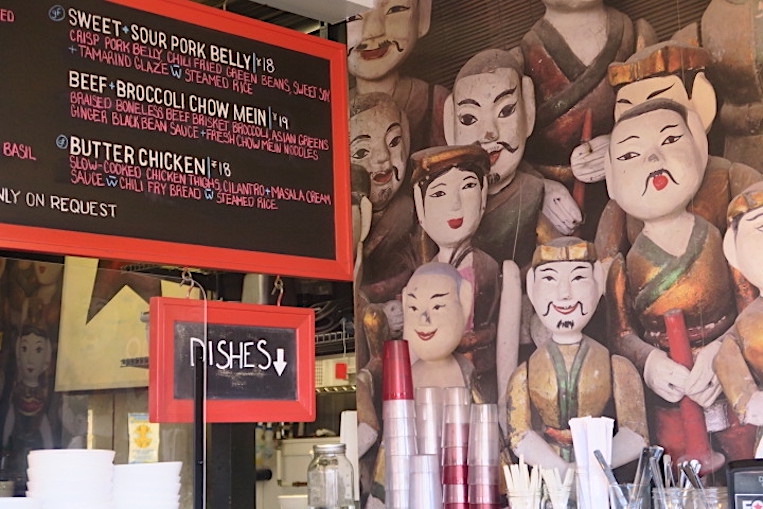
Bright wall murals and fusion cuisine delight customers at Foo Asian Street Food, 769 Yates St, a popular spot near Victoria’s Chinatown neighborhood. photo by Nancy Wigston
And so many bookshops! Most renowned is Munro’s Books, established by Jim Munro in 1984 in a grandly refurbished bank. His first wife, Alice, published fiction in the New Yorker Magazine and then won the 2013 Nobel Prize in Literature. You can never buy too many Alice Munro short story collections, or too many cards showing the bright Muskoka chairs (rather like Adirondack) overlooking the ocean at Willows Beach. (“The Dude Abides” reads the memorial plaque on one.) Munro Books abides too ranked among the world’s top ten bookshops. In a typical Victoria gesture, Jim Munro gave it to his employees after he retired. They were, after all, like family.
Spring in Buenos Aires
Don Jaime’s email sings with excitement. “I have our tickets!” My springtime (our November) trip to Buenos Aires was looming and the plan was to join opera-loving friends, with Don Jaime my opera contact. But getting tickets for The Marriage of Figaro was looking dicey—there had been labor issues and strikes loomed. Fairly normal for Buenos Aires. But suddenly we had seats. The fact that I knew next to nothing about opera was irrelevant—the performance would be held in the 1908 Teatro Colón a splendid venue, a destination worthy of the most sophisticated opera buff.
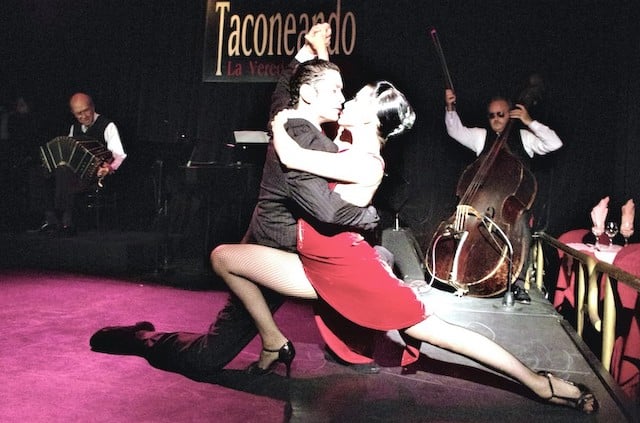
Elegantly supple tango dancers entertain crowds in San Telmo, one of Buenos Aires’ oldest and most historic neighborhoods. Photo by Nancy Wigston
Buenos Aires in spring is a fairyland. Flowering purple jacaranda trees—an import from South Africa—frame a city of parks, ornate fountains, museums, outdoor cafés, and Belle Epoque buildings–the weather neither too hot nor too cold. Gazing out my taxi window, the first English word I read is “Smitten,” graffitied on a wall. When I arrive at The Poetry Building, my apartment-hotel in the upscale Recoleta neighborhood, I find my lodgings well stocked: Brazilian coffee, a bottle of Malbec wine, and fresh pastries.
Taxis are plentiful and cheap and there’s a good subway system too. At the theater entrance, I find Don Jaime, surrounded by friends. We take our seats, and he explains that, in the early days, Argentinian ladies would hang their embroidered shawls over the balcony railings. At intermission, this dapper, silver-haired porteño asks, “What do you think?” “Excellent,” I reply, winging it. Luckily, he agrees. When the performance concludes, the audience stands as one: “Brava!” The mood is buoyant.
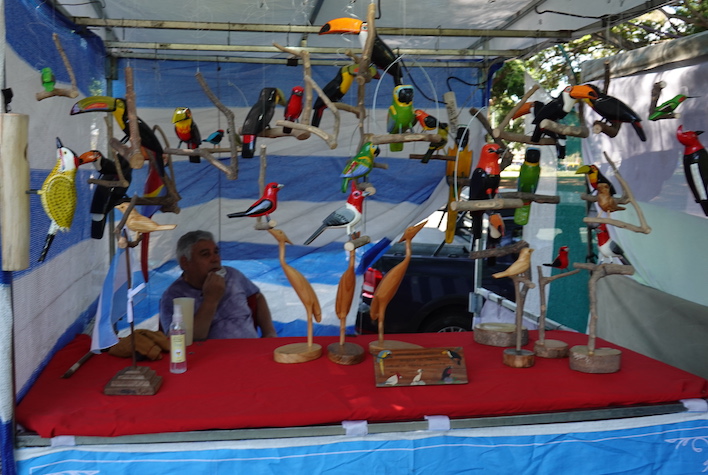
Vendors line the walking paths in the park in front of the National Library and across the street from the Museum of Modern Art in Buenos Aires. Photo by Nancy Wigston
After my taste of the high life in the most musical of South American cities, I decided that theater and dance will be my holiday souvenirs. Opera lessons may be a stretch, but the Tango, the national dance, is very accessible. Even on a quiet Sunday, couples are dancing on Calle Florida, the central pedestrian shopping street, in La Boca, where Italian immigrants lived in brightly painted shipping containers, and on the old streets of San Telmo. Tango shows highlight clubs big and small. When the performance ends, dancers often beckon patrons to join them. If you’re really tempted, private tango lessons can be arranged after a show or with your concierge. And what better souvenir than a pair of handmade tango shoes from Luna Tango?
More than a century ago, Argentina, one of the world’s wealthiest countries, was a major exporter of grain and beef, a legacy that remains in its cuisine (steaks) and fashion (leather goods). Custom leather clothing from Bettina Rizzi and shoes from Jessica Kessel make excellent choices. Central downtown shops offer Argentine specialties—there’s a life-sized horse mannequin in one window—and soft leather goods, silver, woolen blankets, and ponchos tempt the shopper. Is anyone for polo? The Poetry Building’s helpful concierge will arrange a polo day, or, in this home of the 2022 World Cup winners—you might fancy a day at a football match.
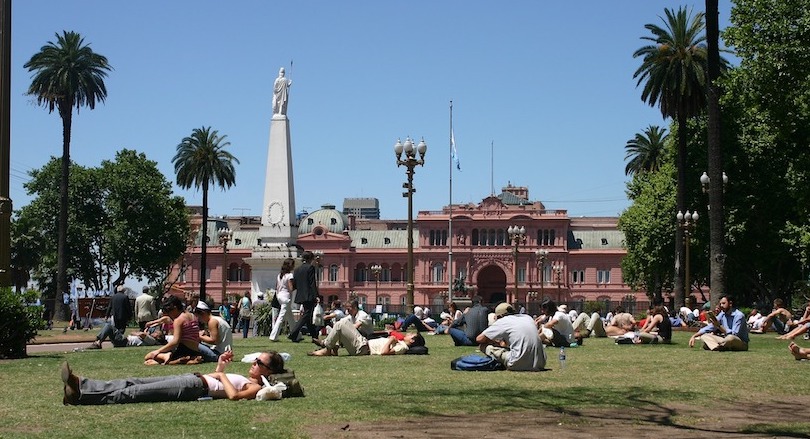
On a sunny Spring Day in Buenos Aires, citizens relax on the grass in Bolivar Square in front of the Casa Rosada Presidential residence.
Today, football reigns, but it was the gaucho who symbolized early Argentina, a hard life captured in the epic poem, “Martín Fierro,” written by José Hernández and published in two parts in the 1870s. A mythic figure, the gaucho was hugely admired and emulated by 1920s Buenos Aires writers like Jorge Luis Borges. Hernández or Borges make great gifts and their work will introduce you to a myriad of independent bookshops. Close to the Poetry Building, on Avenida Santa Fe, you’ll find El Ateneo Grand Splendid one of the world’s truly beautiful bookstores, with 100,000 titles, a large vinyl and tango CD selection and a café on the former stage in this cinema-turned-bookshop that began life in 1919 as a theater.
Summer in Vienna
The city that gave us historical heavy hitters—The Hapsburgs, Mozart, Freud—lights up in summer with humor and energy best captured by University of Vienna drop-out Billy Wilder, whose romantic comedies were his hometown’s greatest gift to Hollywood.
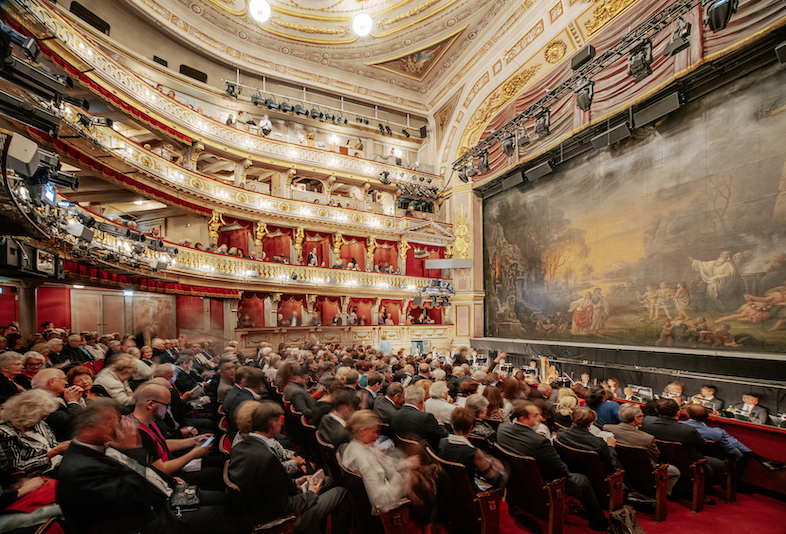
Theater an der Wien Courtesy of Vienna Tourism
At breakfast in the Altstadt Hotel, in the 7th District, founder and art collector Otto Wiesenthal stands by light-filled windows, pointing to the battleground where Vienna and its allies defeated the mighty Ottoman Empire in 1683. The invaders’ morning fires were still smoldering, allowing the Viennese to discover an exotic new drink: coffee. A similar tale explains the Fez-wearing Turk adorning products sold by gourmet tea and coffee vendor Julius Meinl in Vienna’s inner city. Coffee is not an option here, it’s a necessity.
Stepping out into the morning sun, we stroll over to the Museums Quartier, 18th century home to the imperial stables, and now an immense public art space, where vast galleries nudge up against intimate spaces–workshops, cafes, seats for outdoor lounging. Popular Viennese artists like Gustav Klimt and his fellow Austrian Egon Schiele are well represented in The Leopold Museum, although neither’s work is exactly affordable.
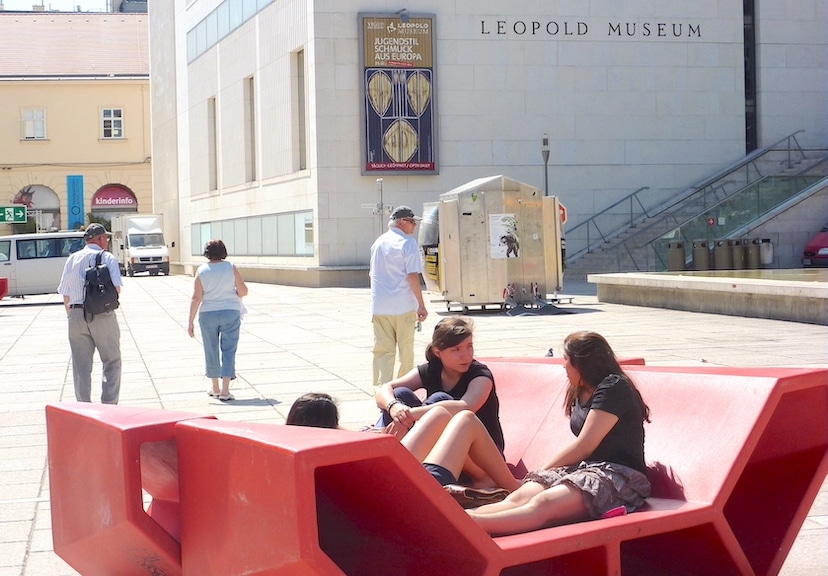
The distinctive outdoor lounge furniture has become a signature item at the MuseumsQuartier, both inviting and artistic. And it has caught on. Hanging out is part of the experience. Colors change periodically, the result of online polls. Photo by Jacqueline Swartz
Art and music are everywhere. The Vienna Music Festival is free and held on an island in the Danube, drawing millions every summer, but you’re just as likely to happen on a klezmer band playing in a summer beer garden. Or chance on a French chanteuse singing at the State Opera House. To capture memories of Vienna, why not try “shooting from the hip” with a Lomo, the analog camera available at Be A Little Analog. The Lomo was a Soviet-era camera that found new life when Viennese friends bought some for cheap on a Prague holiday.
Securing the patent, the friends founded the Lomography Society in 1992. A youthful camera cult was born, offering the inexpensive “classic Lomo” along with variations–fish-eye lenses, colored flashes, special film, stylish cases– “cheap, democratic, and for the people.” Today Fans from Seoul to Dubai submit shots in the millions to the Lomo website. Colorful, often blurred or overexposed, they are spontaneous, modern, artistic and win contests. Terrific souvenirs, Lomos capture Vienna in fresh ways.
A few blocks north is Mariahilferstrasse, Vienna’s longest shopping street, where the Saturday flea market offers a range of weird items. Creative upcycling is the specialty at Gabarage where folks get their lives back on track by making furniture and accessories—what say you to a lampshade made from discarded x-rays or shelving made from old highway signs? Worth a look. My deepest regret is passing on a wonderful painting at a pop-up art show–pricey at 899 Euros and too large for my carry-on. But I fondly remember that canvas: three ebullient swimmers splashing happily in the surf on a summer’s day.
Heading south, we reach the city center and The Museum of Applied Art with its edgy exhibits, light lunch fare, and intriguing shop, where a t-shirt sports Billy Wilder’s famous line from Some Like It Hot, “Nobody’s perfect.” But this area, with its Renaissance courtyards, Baroque facades, famous schnitzel place (Figlmuller) and 12th-century St Stephen’s Cathedral, approaches perfection. Chocolate shops and cafes entice the wanderer. After perusing the bookshop at The Jewish Museum we slip into the museum’s Café Eskeles for restorative tea and slices of raspberry cake.
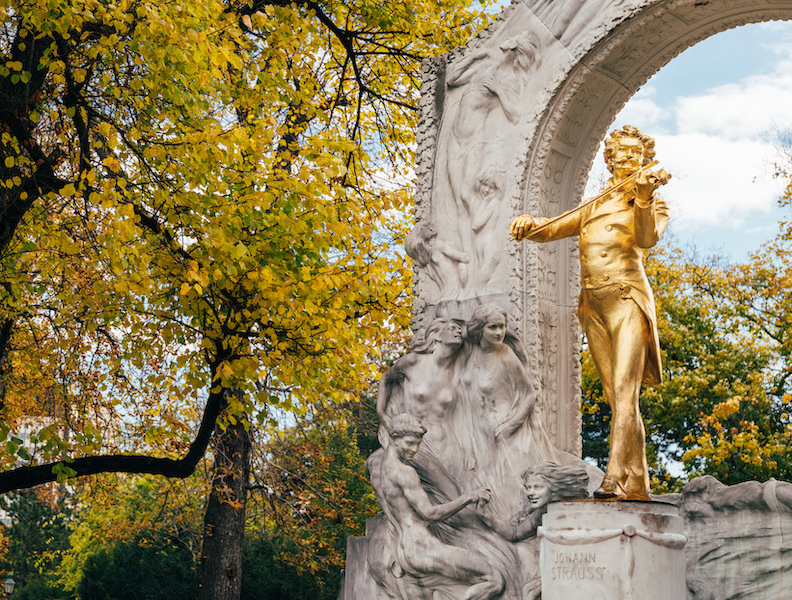
The golden Johann Strauss sculpture illuminates one of Vienna’s many enchanting parks, capturing the spirit of Vienna’s waltz maestro. Photo by Vienna Tourism
Fully half of Vienna is green space, so warm nights are perfect for salsa dancing on The Danube’s urban “beaches” or sipping iced coffee mit schlag at the Kursalon, where waltzing couples celebrate summer in honor of music master Johann Strauss, whose statue shines golden under the trees, just a short walk away.
Autumn in Northern Thailand
In the mountainous Golden Triangle, where the borders of Thailand, Burma (Myanmar) and Laos meet, ethnic minorities–Lisu, Lahu, Akha, Karen, and more—mostly eke out existences as hill farmers. Decades ago, when I first visited Chiang Mai, Thailand’s second-largest city, its Night Market was bursting with the latest DVDs, trendiest sportswear, jewelry and antiquities. Bars and blues clubs made visitors feel right at home. It’s much the same today.
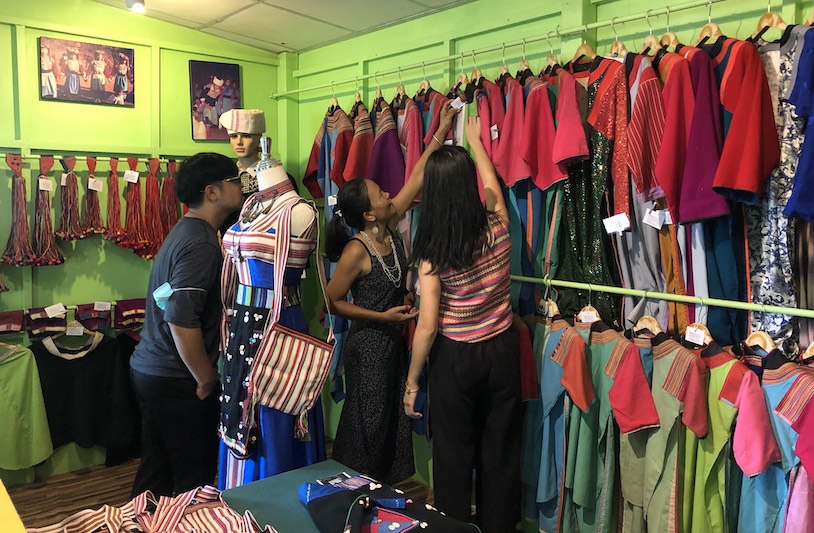
Mimi Saeju (center), shows interested visitors handicrafts in the Lisu Cultural Center, a bright green building built by her father that she designed in Chiang Mai. Photo supplied by Mimi Saeju
From Chiang Mai I traveled to a mountain village, Doi Laan (“See the Tiger”), where I met Mimi, a Lisu child, on a dirt path. I recognized her dress. It had been a favorite of my own daughter. Since a Dutch anthropologist friend had settled here, I’d been sending her boxes of children’s clothes and school supplies. All grown up now, Mimi fondly calls me “Auntie,” in the way of the East.
During our recent visit to Chiang Mai—September and October are very comfortable–a black SUV pulled into the parking lot of the colonial-themed Ping Nakara Hotel. “Good morning, Auntie!” Mimi calls excitedly as we climb aboard. At the helm is Mimi’s boyfriend, Joe. After a two-hour drive on a smooth new highway, Joe pulls into a spanking new plaza to gas up. At a café, we order locally-grown coffee. Cappuccino in hand, I remember my first visit to the Golden Triangle, three decades back.
In a region famed for its opium–a cash crop banned in 1984—farmers were struggling to find replacement crops. Lodging in my friend’s thatched bamboo hut, sipping Nescafé by a smoky wood fire, I shared meals with Mimi’s grandparents, dazzled by mountain vistas by day and starry canopies by night. Before sleep, I sealed my contact lenses in a baggie pegged on a clothesline, “so the rats won’t get them.” Mimi’s grandmother’s surprise parting gift–a handwoven purse—brought tears to my eyes.
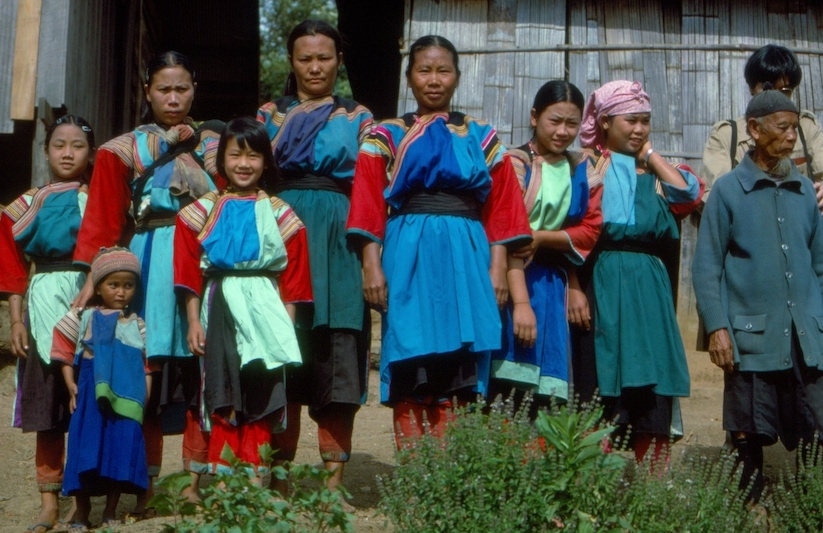
Lisu women are distinguished by their colorful dresses and tribal handicrafts. Photo by David DeVoss
Today Mimi speaks fluent English, (plus Thai and Lisu), holds an MA in Ethnic Minority Studies from Chiang Mai University, has traveled to the U.S. on an Ethnic Studies program, and chatted with President Obama on his Laos trip.
Combining her degrees with her boundless energy, Mimi built the Lisu Center (soi 2, 80, Bamrungrat, near 15th century Wat Ket)–a showcase for Lisu crafts, jewelry, and history. Trekking to a hill village is always an adventure, but for those pressed for time, the Lisu Center offers authentic handicrafts that support hill tribe women.
Mimi will also arrange home visits. Last winter, a group of American women “stitchers” came to Doi Laan to spend an afternoon learning traditional handicrafts from village ladies and enjoy lunch served in the airy mountains above the city. A woman on a mission to recharge her people’s dying arts, Mimi is not alone. A young Akha entrepreneur markets his people’s organic Arabica beans locally and internationally, while other tribal projects have been championed by the Thai Royal family. As for opium, it has its own museum in the northern town of Chiang Rai.
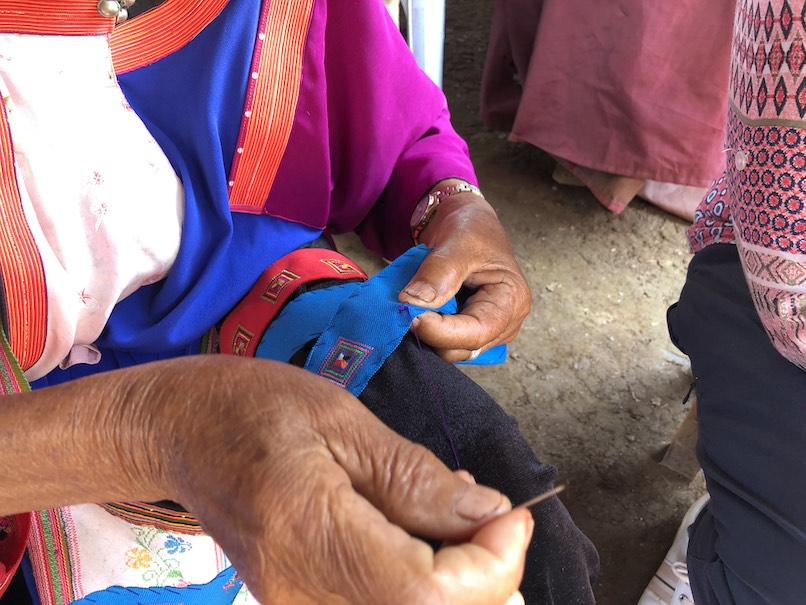
Skilled hands demonstrate traditional Lisu stitching methods to western visitors eager to learn and revive the old arts of the mountain peoples of Northern Thailand. photo by Mimi Saeju
To Westerners, a visit to remote villages can seem like afternoons in paradise. Still, few villagers have fared as well as Mimi, whose parents sent their ambitious daughter to a Buddhist-run residential school in the south. (She saw them once a year until graduation.) Recently, when a Thai soccer team, largely made up of ethnic minorities, made headlines when they were trapped deep within mountain caves, Mimi wrote to say her mother and other villagers, concerned for the boys, wondered if offerings to the cave spirit would help free them. Like traditional craftsmanship, these beliefs are testaments to the enduring identity of the mountain peoples of the Golden Triangle.![]()
Nancy Wigston is a Toronto writer who previously wrote about London’s spy trail and peripatetic mystery novelist Agatha Christie.

